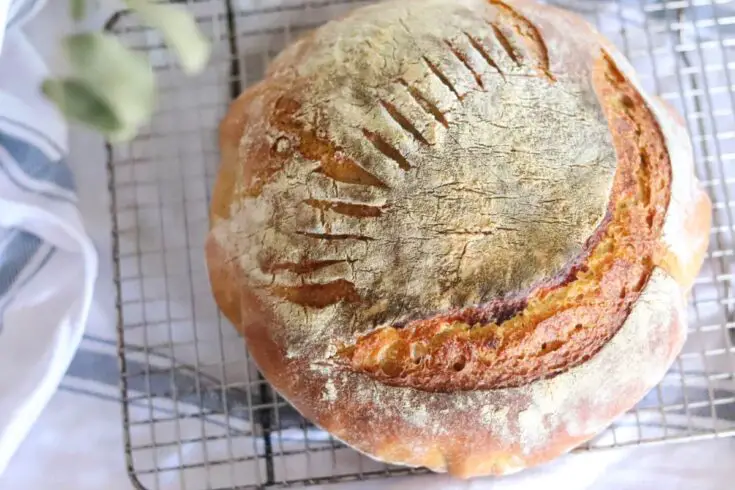No-Knead Einkorn Sourdough Bread Loaf

Learn how to make no knead sourdough einkorn bread. Einkorn is a healthy ancient grain, that is higher in protein and lower and gluten. If you have an established sourdough starter you can make your own einkorn bread at home with this easy recipe and tutorial.
Ingredients
- 1 cup fed, active einkorn sourdough starter (note if you are using a regular flour sourdough starter, use slightly less starter, about 3/4 cup). The einkorn starter is fed 1 cup einkorn flour and 1/2 cup filtered water before starting this recipe.
- 1.5 cups warm filtered water
- 1.5 tsp course sea salt
- 4 cups einkorn flour
- Two pinches of extra flour, to be used in the shaping and baking process
Instructions
PHASE 1 – MAKE THE DOUGH (3 MIN)
Pour the fed and active einkorn sourdough starter and water into a large mixing bowl and whisk together with a fork. If you’re not sure if your starter is ready, do the “float test” described above.
Add the einkorn flour and salt. With clean hands, combine all ingredients for about 20 seconds until all the flour is cleaned off the sides of the bowl. The dough will feel sticky. Do not overdo it here.
Let the dough rest. Put a tea towel on top of the bowl and set on the counter for 30 minutes to an hour.
PHASE 2 – LIFTS AND TUCKS (1 MIN)
Sounds like an exercise routine, but it’s just some hand motions on the dough
Starting from one end of the dough, lift it up and fold it over itself into the center of the dough. Then rotate the bowl 90 degrees and repeat, until all sides have been lifted, tucked and folded. So, four times total.
Cover the bowl and let sit on the counter. Then, repeat the lifts and tucks 2 more times (for a total of 3 times), each about one hour apart. Now, don’t get too obsessed with this part. This is just creating nice volume in your bread. If you skip one or let two hours go by instead of one, it’s totally okay.
PHASE 3 – BULK FERMENT (30 SEC)
The easiest (and most important) phase!
Cover the bowl with saran wrap and then a tea towel on top. Place in the fridge and let sit overnight.
PHASE 4 – SECOND RISE (5 MIN)
Pull the dough out of the fridge and clear a spot on your countertop. On half the counter, sprinkle some flour and leave the other half clean with no flour.
Remove the dough from the bowl and place on the flour side. Do one more round of the lift and tucks to form your dough.
Remove the dough from the flour side, flip it over, and set it on the non-flour side. Form the letter C with your hands and use a cupping motion around the dough to create a ball. Rotate the ball with short rotations in a circle. You should have a dough ball that is easy to pick up and not sticky now. Add more flour if the dough is too sticky.
Grab a sheet of parchment paper and set the dough on the parchment paper.
Pick up the parchment paper and set the dough in a dutch oven. Cover with a tea towel and let sit on the counter for at least 2 hours.
PHASE 5 – BAKE THE BREAD (FINALLY!)
First, take your bread that was rising in the dutch oven out of the dutch oven.
Turn your oven onto 450 degrees F and place the dutch oven (empty) into the oven to preheat with it.
Once the oven is preheated, score your bread. Scoring is the process of creating a slit in the dough so that it can breath and rise in the oven. You can buy a special scoring knife to do this, but we just use a serrated knife and it works perfectly.
Create one or two slits in the bread with a serrated knife or bread lame. Or, try your own design. Here I did one large slit on one side followed by several tiny lines on the other side.
Carefully place the parchment paper with the bread on it inside of the dutch oven.
Cover the dutch oven and, with the bread inside, place it in the oven.
Bake for 25 minutes with the lid on, and then another 20 minutes with the lid off. Note: this time can vary depending on your oven and how crispy you like the outside of the bread. For less crispy, try 20 minutes lid on and 15 minutes lid off. Experiment until you get it just right!
THIS LAST STEP IS THE MOST IMPORTANT.
WHEN THE BREAD IS DONE, DO NOT CUT IT. You will be tempted to cut it open right away and devour it. I know the smell of freshly baked bread can be hard to resist, but don’t do it. We’ve done it and learned from our mistakes.
The bread needs to sit for an hour in order to finish cooking. If you place your ear right next to the bread, you can hear it crackling. Transfer it to a cooling rack so it can properly cool. Don’t worry, it will still be hot inside after an hour!
Notes
Sample Baker's Timeline
Saturday morning: Take starter out from the fridge and feed it. Let sit on the counter all day until it passes the float test (when a spoonful of starter floats in a cup of water).
On Saturday afternoon: Phase 1 – Make the Dough
Then Saturday lafter afternoon/evening: Phase 2 – Lift and Tucks
Saturday over night: Phase 3 – Bulk Rise
Sunday morning: Phase 4 – Second Rise
Sunday afternoon: Phase 5 – Bake the Bread